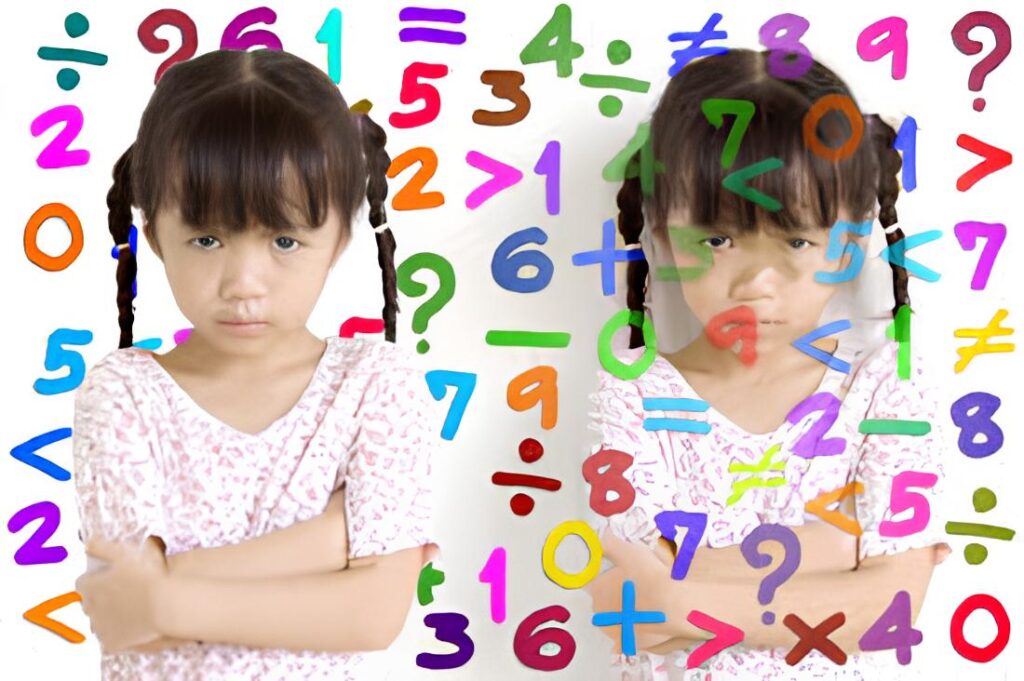Definition of Dyscalculia
Dyscalculia is a specific learning disability that impairs a person’s ability to understand and work with numbers. It disrupts the typical development of arithmetic skills and affects a person’s confidence in handling everyday tasks involving math. Research suggests, it is largely brain-based, with differences observed in areas of the brain responsible for numerical understanding—particularly the left parietotemporal region. However, poor early teaching, limited learning opportunities, and emotional neglect may also contribute to its development.
Types of Dyscalculia
Presents in different forms, each affecting a unique aspect of mathematical learning:
1. Verbal Dyscalculia – Difficulty understanding or recalling math-related terms and explaining problems aloud.
2. Practognostic Dyscalculia – Trouble using objects or visual aids like counters for solving math problems.
3. Lexical Dyscalculia – Challenges in reading numbers, symbols, or math equations accurately.
4. Graphical Dyscalculia – Struggles with writing numbers or aligning equations correctly on paper.
5. Ideognostical Dyscalculia – Difficulty grasping abstract math concepts such as fractions or mathematical relationships.
6. Operational Dyscalculia – Problems performing basic arithmetic operations like addition or multiplication.
Causes
While the exact cause remains uncertain, several factors contribute:
Neurological Differences : Brain scans show structural and functional differences, especially in the parietal lobe, affecting number processing and calculation.
Genetic Factors: A family history of learning disorders increases the likelihood of dyscalculia.
Co-existing Conditions: Often found alongside ADHD, dyslexia, or autism, which can impact attention and memory.
Premature Birth: Children born prematurely or underweight may face higher risks of cognitive delays.
Environmental Factors: Lack of early exposure to numbers, poor teaching methods, and math anxiety at home can hinder math development.
Brain Injury: In rare cases, it can be acquired later due to trauma, stroke, or neurological disease.
Symptoms

Symptoms vary with age but often include:
In Young Children: Difficulty counting, recognizing numbers, telling time, or understanding quantity.
In School-Age Children: Confusion with math symbols, poor number sense, problems with place value, and heavy reliance on fingers for counting.
In Teens and Adults: Struggles with budgeting, estimating time or distance, mental math, and math-related anxiety.
Diagnosis

Diagnosis involves:
Reviewing educational and developmental history.
Conducting cognitive and psychological testing.
Administering math skill assessments.
Gathering teacher and caregiver observations.
Ruling out other causes like poor instruction or sensory issues.
Early identification allows for tailored interventions and reduces academic stress.
Conclusion
It can significantly impact academic performance, daily functioning, and self-confidence if left unaddressed. But with early detection, supportive teaching methods, and individualized learning strategies, those with dyscalculia can thrive. At Aaziban,we emphasize awareness, inclusive education, and evidence-based intervention to empower individuals with dyscalculia to reach their full potential.
1. What is dyscalculia and how does it affect individuals?
Dyscalculia is a brain-based learning disability that impairs a person’s ability to understand numbers and perform arithmetic. It affects confidence and daily tasks involving math.
2. What are the main types of dyscalculia?
Types include verbal, practognostic, lexical, graphical, ideognostical, and operational dyscalculia—each affecting different aspects like number recognition, problem-solving, and math comprehension.
3. How is dyscalculia diagnosed?
Diagnosis involves reviewing academic history, conducting cognitive and math assessments, collecting teacher input, and ruling out other causes like poor instruction or sensory issues.

